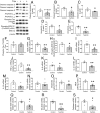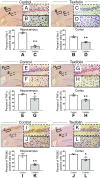Pleiotropic neuroprotective effects of taxifolin in cerebral amyloid angiopathy
- PMID: 31036637
- PMCID: PMC6525485
- DOI: 10.1073/pnas.1901659116
Pleiotropic neuroprotective effects of taxifolin in cerebral amyloid angiopathy
Abstract
Cerebral amyloid angiopathy (CAA) results from amyloid-β deposition in the cerebrovasculature. It is frequently accompanied by Alzheimer's disease and causes dementia. We recently demonstrated that in a mouse model of CAA, taxifolin improved cerebral blood flow, promoted amyloid-β removal from the brain, and prevented cognitive dysfunction when administered orally. Here we showed that taxifolin inhibited the intracerebral production of amyloid-β through suppressing the ApoE-ERK1/2-amyloid-β precursor protein axis, despite the low permeability of the blood-brain barrier to taxifolin. Higher expression levels of triggering receptor expressed on myeloid cell 2 (TREM2) were associated with the exacerbation of inflammation in the brain. Taxifolin suppressed inflammation, alleviating the accumulation of TREM2-expressing cells in the brain. It also mitigated glutamate levels and oxidative tissue damage and reduced brain levels of active caspases, indicative of apoptotic cell death. Thus, the oral administration of taxifolin had intracerebral pleiotropic neuroprotective effects on CAA through suppressing amyloid-β production and beneficially modulating proinflammatory microglial phenotypes.
Keywords: cerebral amyloid angiopathy; neuroprotection; taxifolin; triggering receptor expressed on myeloid cell 2.
Conflict of interest statement
The authors declare no conflict of interest.
Figures




Similar articles
-
Taxifolin inhibits amyloid-β oligomer formation and fully restores vascular integrity and memory in cerebral amyloid angiopathy.Acta Neuropathol Commun. 2017 Apr 4;5(1):26. doi: 10.1186/s40478-017-0429-5. Acta Neuropathol Commun. 2017. PMID: 28376923 Free PMC article.
-
Novel Therapeutic Potentials of Taxifolin for Amyloid-β-associated Neurodegenerative Diseases and Other Diseases: Recent Advances and Future Perspectives.Int J Mol Sci. 2019 Apr 30;20(9):2139. doi: 10.3390/ijms20092139. Int J Mol Sci. 2019. PMID: 31052203 Free PMC article. Review.
-
Potential Therapeutic Approaches for Cerebral Amyloid Angiopathy and Alzheimer's Disease.Int J Mol Sci. 2020 Mar 14;21(6):1992. doi: 10.3390/ijms21061992. Int J Mol Sci. 2020. PMID: 32183348 Free PMC article. Review.
-
Taxifolin: A Potential Therapeutic Agent for Cerebral Amyloid Angiopathy.Front Pharmacol. 2021 Feb 12;12:643357. doi: 10.3389/fphar.2021.643357. eCollection 2021. Front Pharmacol. 2021. PMID: 33643053 Free PMC article. Review.
-
Minocycline reduces spontaneous hemorrhage in mouse models of cerebral amyloid angiopathy.Stroke. 2015 Jun;46(6):1633-1640. doi: 10.1161/STROKEAHA.115.008582. Epub 2015 May 5. Stroke. 2015. PMID: 25944329 Free PMC article.
Cited by
-
Nailfold Capillaroscopy: A Comprehensive Review on Its Usefulness in Both Clinical Diagnosis and Improving Unhealthy Dietary Lifestyles.Nutrients. 2024 Jun 18;16(12):1914. doi: 10.3390/nu16121914. Nutrients. 2024. PMID: 38931269 Free PMC article. Review.
-
New Perspectives of Taxifolin in Neurodegenerative Diseases.Curr Neuropharmacol. 2023;21(10):2097-2109. doi: 10.2174/1570159X21666230203101107. Curr Neuropharmacol. 2023. PMID: 36740800 Free PMC article. Review.
-
Hepatoprotective and neuroprotective effect of taxifolin on hepatic encephalopathy in rats.Metab Brain Dis. 2022 Jun;37(5):1541-1556. doi: 10.1007/s11011-022-00952-3. Epub 2022 Mar 17. Metab Brain Dis. 2022. PMID: 35298730
-
A Narrative Review of the Effects of Citrus Peels and Extracts on Human Brain Health and Metabolism.Nutrients. 2022 Apr 28;14(9):1847. doi: 10.3390/nu14091847. Nutrients. 2022. PMID: 35565814 Free PMC article. Review.
-
7-O-Esters of taxifolin with pronounced and overadditive effects in neuroprotection, anti-neuroinflammation, and amelioration of short-term memory impairment in vivo.Redox Biol. 2020 Jan;29:101378. doi: 10.1016/j.redox.2019.101378. Epub 2019 Nov 9. Redox Biol. 2020. PMID: 31926632 Free PMC article.
References
Publication types
MeSH terms
Substances
LinkOut - more resources
Full Text Sources
Miscellaneous

